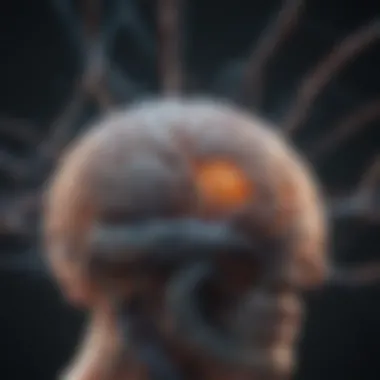Exploring the Intricacies of Brain Applications


Intro
The field of brain science has grown exponentially in recent years. This expansion has led to a myriad of applications across various sectors. Each application not only harnesses current knowledge but also pushes the boundaries of our understanding of the brain. From revolutionizing artificial intelligence to improving mental health therapies, the influence of neuroscience is profound.
As researchers and professionals delve deeper into the complexities of the brain, we see the emergence of ethical questions intertwined with advancements. This makes it crucial to explore the implications these developments have on society as a whole. Understanding how brain science factors into education and technology opens the door to a future where these disciplines intersect with human experience.
The subsequent sections aim to shed light on key areas of brain science, helping students, researchers, and practitioners grasp the importance of these intriguing developments. One will also examine how ethical considerations shape the future of these applications.
Research Highlights
Overview of Key Findings
Recent research has highlighted several significant applications of brain science:
- Artificial Intelligence: Algorithms inspired by the way the brain processes information are revolutionizing machine learning.
- Mental Health: Advancements in neuroimaging allow for more accurate diagnoses and effective treatments.
- Education: Understanding cognitive functions enhances teaching methodologies and learning outcomes.
These findings underscore the essential nature of brain applications in everyday life. They illustrate how a better understanding of our neurological functions can lead to substantial improvements in multiple domains.
Significance of the Research
The implications of these discoveries extend beyond academic interest. They have the potential to reshape industries, particularly in technology and healthcare. With neural networks and deep learning, AI systems can mimic human thought processes, enabling advancements previously thought unattainable. In mental health, the power of neurobiology aids in developing personalized treatment plans that cater to individual needs.
Moreover, in the realm of education, brain science contributes to creating tailored learning environments. This signifies a shift towards more evidence-based practices that acknowledge the unique cognitive profiles of learners.
"The synergy between brain science and various sectors is paving the way for future innovations, emphasizing the need for ethical considerations along the way."
By examining these key areas, the research cultivates a comprehensive understanding of how brain science operates in practical settings.
Original Research Articles
Summary of the Article
The article synthesizes current research findings in neuroscience with a focus on practical applications. It addresses the interconnections between brain science, technology, mental health, and education. Each segment provides insights about recent advancements, as well as their societal impact.
Author Contributions
The authors of the original research emphasize a collaborative approach. Experts from neuroscience, psychology, and education work together to present a multifaceted view of the topic. This cooperation enhances the depth of information provided and enriches the conversation surrounding the ethically complex nature of brain applications.
In summary, it is essential to grasp the intricacies of brain science applications. They hold the key to unlocking future advancements while considering the ethical implications of these developments.
Prolusion to Brain Applications
The exploration of brain applications is a significant domain in contemporary neuroscience. This area not only investigates the biological foundations of brain function but also translates these findings into practical uses that can improve various aspects of life. The relevance of understanding brain applications spans multiple sectors, including healthcare, education, and technology, highlighting their profound implications for society.
One key component in discussing brain applications is the integration between neuroscience and technological advancements. We are seeing a rapid progression in the way brain research informs artificial intelligence, leading to neural networks that mimic human cognition. These developments not only advance computing power but also enhance our understanding of brain diseases, helping in diagnosis and treatment strategies.
Furthermore, brain applications play a vital role in education. By applying cognitive principles, educators can design more effective learning tools and environments. This intersection illustrates the potential for optimized teaching methods that cater to various learning styles, ultimately promoting better educational outcomes.
Insights into brain applications also raise critical ethical considerations. Privacy concerns regarding individual data, informed consent in research, and the potential for technological misuse emerge as significant issues. As society increasingly relies on brain-related technologies, it is essential to navigate these challenges cautiously.
In summary, the importance of exploring brain applications lies in its ability to bridge theoretical research and practical implementation. The implications of these applications not only affect individual lives but also shape future research and societal norms. Understanding these intricacies is crucial for fostering advancements that are both beneficial and ethically sound.
Neuroscience Fundamentals
Understanding neuroscience fundamentals is essential for appreciating the broader implications of brain applications in diverse fields. This section sheds light on key concepts that underpin brain function, offering insights that are crucial for students, researchers, educators, and professionals alike. Grasping these fundamentals not only enhances one’s comprehension of the brain but also informs the applications that emerge from this knowledge in healthcare, education, and artificial intelligence.
Basic Brain Anatomy


The human brain is a complex organ comprising several regions, each with distinct functions. At a high level, the architecture can be divided into three main parts: the cerebrum, the cerebellum, and the brainstem.
- Cerebrum: The largest part of the brain, responsible for higher cognitive functions, including thought, emotion, and voluntary movement. It is divided into two hemispheres, further segmented into four lobes: frontal, parietal, occipital, and temporal. Each lobe plays a specific role, ranging from processing sensory information to managing complex reasoning tasks.
- Cerebellum: Located at the back of the brain, this structure is crucial for coordination, balance, and fine motor skills. It ensures smooth execution of movements, and it also has roles in cognitive functions like attention and language.
- Brainstem: Connecting the brain to the spinal cord, the brainstem governs essential bodily functions, such as breathing, heart rate, and consciousness. It acts as a conduit for signals between the brain and the rest of the body.
Understanding this basic anatomy is the first step in exploring how these structures interact and contribute to the broader applications of brain science.
Neurotransmitters and Their Roles
Neurotransmitters are chemical messengers that facilitate communication between neurons. Their roles are diverse and vital to brain function. Each neurotransmitter has specific functions and pathways, influencing various aspects of behavior and cognitive processes.
- Dopamine: Often dubbed the "feel-good" neurotransmitter, dopamine is associated with the brain's reward system. It plays a role in motivation, pleasure, and motor control.
- Serotonin: Important for mood regulation, serotonin also impacts sleep, appetite, and digestion. Its imbalance is frequently linked to mood disorders such as depression.
- Acetylcholine: This neurotransmitter is crucial for learning and memory. It mediates communication between neurons and is involved in muscle activation.
By examining these chemical interactions, researchers can better understand, for example, how certain therapies may address neurological disorders or how brain-computer interfaces may manipulate these pathways for enhanced cognitive functions.
Neural Plasticity
Neural plasticity, or neuroplasticity, is the brain’s ability to adapt and reorganize itself. This phenomenon occurs at different levels, from cellular changes (involving neurons and synapses) to large-scale cortical remapping.
- Developmental plasticity: This type refers to the changes that occur in the brain during development, shaping how the brain encodes and retrieves information.
- Functional plasticity: This involves the brain's ability to shift functions from damaged areas to healthier regions. For instance, after a stroke, undamaged parts may take over the lost functions.
Neuroplasticity has implications in rehabilitation therapies, cognitive training, and even in educational paradigms. Recognizing that the brain is not static but capable of change leads to innovative approaches in both healthcare and learning environments. Understanding these mechanisms may pave the way for discoveries that enhance cognitive abilities or recovery from trauma.
"The brain is a dynamic organ that continuously adapts in response to experiences, making it a key player in our understanding of both health and learning."
In summary, grasping the intricacies of brain anatomy, neurotransmitter functions, and neural plasticity lays a strong foundation for further exploration of brain applications. Each component interplays intricately with the others, contributing to our ability to understand human cognition and behavior.
Applications in Healthcare
The intersection of neuroscience and healthcare represents a vital area of exploration. Understanding the brain's complexities can lead to significant advancements in diagnosis, treatment, and patient care. Brain applications in healthcare are not just limited to the direct treatment of neurological disorders, but they also extend to overall patient well-being and mental health management. Public expectations are rising, and with these advancements come both opportunities and challenges.
Neuroimaging Techniques
Neuroimaging techniques play a crucial role in modern healthcare by allowing medical professionals to visualize and assess brain activity. Techniques such as Functional Magnetic Resonance Imaging (fMRI) and Positron Emission Tomography (PET) provide critical insights into brain function and detailed structural images. These tools help in the diagnosis of conditions like Alzheimer's disease, epilepsy, and tumors. They can also monitor changes in the brain over time, enabling healthcare providers to tailor treatment plans effectively.
"Neuroimaging not only enhances our understanding of brain function but also opens the door to more targeted therapies that improve patient outcomes."
The development of advanced imaging technologies fosters a deeper understanding of mental disorders and their physiological underpinnings. This engagement between brain function and therapy exemplifies the necessity of ongoing research and innovation in healthcare applications.
Brain-Computer Interfaces
Brain-Computer Interfaces (BCIs) represent a transformative approach in treating various neurological conditions. Through BCIs, individuals can control devices through brain signals, which is particularly beneficial for those with severe disabilities. Companies like Neuralink and research institutions worldwide are working to refine this technology. This creates opportunities for increased independence for users. Furthermore, BCIs can facilitate rehabilitation for patients recovering from strokes or traumatic injuries by providing feedback and encouraging engagement in physical therapy.
The potential for BCIs to change lives is profound. However, these developments raise questions about accessibility and ethics. Ensuring equitable access to these innovative solutions is a significant concern that must be addressed to maximize their benefits.
Neuromodulation Therapies
Neuromodulation therapies have emerged as a promising field in addressing a wide array of health issues. Techniques, such as Transcranial Magnetic Stimulation (TMS) and Deep Brain Stimulation (DBS), are becoming standard for treating depression, chronic pain, and movement disorders. These therapies work by modulating neuronal activity, potentially leading to sustained changes in brain function.
The effectiveness of these therapies can vary based on individual patient needs, demanding a personalized approach to treatment. As research progresses, exploring the long-term effects and ideal application settings for neuromodulation will be crucial. Ethical considerations regarding patient consent and potential side effects remain points of focus in ongoing discussions.
The integration of these applications in healthcare is reshaping the landscape of medical treatment and showcases the transformative potential of understanding the brain's intricacies.
Brain Applications in Education
The intersection of brain science and education is a vital area of study. Understanding how the brain learns can greatly enhance teaching strategies and learning methodologies. Brain applications in education not only focus on cognitive development but also on optimizing learning processes. Integrating insights from neuroscience into educational practices provides a framework for addressing diverse learning needs.
Educators can leverage findings from brain research to develop tailored educational approaches for students. This empowerment directly improves learning outcomes and promotes a more inclusive educational environment. Overall, it underscores the need for educational systems to embrace and apply brain science.


Cognitive Load Theory
Cognitive Load Theory, proposed by John Sweller, is a crucial concept in educational psychology. It posits that the capacity of working memory is limited, and excessive cognitive load can hinder learning. This theory categorizes cognitive load into intrinsic, extraneous, and germane types.
- Intrinsic Load: Relates to the complexity of the material. More challenging content naturally increases cognitive load.
- Extraneous Load: Resulting from unnecessary information or poorly designed instructional materials. It is vital to minimize this to enhance learning.
- Germane Load: Associated with processes that optimize learning. This is the desirable cognitive load that helps with understanding and retention.
Effective application of this theory can guide educators in designing curriculum and instructional strategies that align with the brain’s capabilities. For example, breaking complex tasks into smaller sub-tasks can help in reducing intrinsic load.
Gamification in Learning
Gamification refers to integrating game-like elements into educational settings to motivate and engage learners. By using points, leaderboards, or achievements, educators can create an interactive classroom environment. Neuroscience supports this approach, as game mechanics activate the brain's reward system, enhancing motivation.
- Engagement: Gamified elements can capture student attention and increase participation.
- Immediate Feedback: Games often provide instant feedback, allowing learners to adjust their approach quickly. This responsiveness is crucial for effective learning.
- Collaboration: Many gamification strategies encourage teamwork, fostering social interaction among students.
Applying gamification can lead to deep engagement and a positive emotional experience in learning, making the content more relatable and enjoyable.
Mindfulness and Cognitive Development
Mindfulness practices have gained traction in education, aiming to advance students' focus, emotional regulation, and overall cognitive function. Mindfulness helps learners cultivate awareness of their thoughts and emotions, promoting a calmer mindset that is conducive to learning.
- Improved Attention: Regular mindfulness practice can enhance attention spans and reduce distractions.
- Stress Reduction: Mindfulness techniques lower stress responses, which can be especially beneficial during exams or intense study sessions.
- Enhanced Memory: Studies suggest that mindfulness may improve working memory, allowing for better information retention.
By incorporating mindfulness into educational routines, educators can help students become more present and focused, directly impacting their learning capacities. As educators continue to explore these techniques, the potential benefits become clearer, highlighting the importance of mental health in learning environments.
"Incorporating brain applications in education not only transforms teaching but also shapes how students engage with their learning journey."
The concepts addressed in this section set the stage for a comprehensive understanding of how neuroscience can be applied to education. Creating learning strategies based on cognitive science principles represents a progressive approach to education, aiming at better outcomes for all learners.
Artificial Intelligence and the Brain
The integration of artificial intelligence (AI) within brain science is a rapidly evolving field, blending two complex domains. Understanding this intersection is critical. AI is transforming not only how we process information but also how we understand cognitive functions and neurological disorders. This section will delve into the neuroscience principles that inform AI development, the relationship between machine learning and neural networks, and the ethical considerations that accompany these technological advancements.
Neuroscience Principles in AI
Neuroscience provides a foundational framework for the development of AI. Key principles drawn from brain function and structure influence algorithms that drive AI systems. Concepts such as neural encoding, synaptic plasticity, and the architecture of neuronal circuits guide the replication of cognitive processes.
- Neural Encoding: Mimicking how the brain converts stimuli into neural signals helps improve pattern recognition algorithms.
- Synaptic Plasticity: Understanding how neural connections strengthen or weaken over time is crucial in developing adaptive AI systems that learn from experience.
- Cortical Structures: The organization of the cortex offers insights into how AI can mimic human brain functions.
By emulating these principles, AI systems can become more efficient in processing information, similar to how the human brain operates.
Machine Learning and Neural Networks
Machine learning is at the heart of modern AI. It leverages algorithms to parse data, recognize patterns, and make decisions. Neural networks, inspired by the structure of the human brain, play a vital role in this process. They consist of interconnected layers of nodes, each representing a neuron, enabling the model to learn from vast datasets.
- Artificial Neural Networks: These are designed to simulate the way biological neurons communicate, enhancing tasks such as image and speech recognition.
- Deep Learning: A subset of machine learning that uses multiple layers in neural networks to improve accuracy and functionality in tasks ranging from medical diagnosis to autonomous vehicles.
These technologies are not just advancements in computing; they represent a significant amplification of human capability in interpreting complex data.
Ethical Considerations in AI Development
As AI continues to evolve, ethical concerns surrounding its use are paramount. These issues must be carefully considered to prevent negative impacts on society and ensure responsible development. Key ethical considerations include:
- Privacy Concerns: The collection and analysis of brain data can lead to significant breaches of individual privacy. It's essential to establish guidelines that protect patient information when using personal neural data.
- Informed Consent: Participants in neuroscience research must be fully aware of how their data will be used, particularly in AI applications that may alter decision-making processes.
- Potential for Misuse of Technology: The power of AI can be abused, leading to manipulation or exploitation. Creating safeguards against misuse is crucial in maintaining trust in these technologies.
"Artificial intelligence holds the potential to revolutionize our understanding of the brain, but with such power comes responsibility."
Ethical Implications of Brain Applications


The evolving landscape of brain applications necessitates a thorough exploration of their ethical implications. As technology begins to tap deeper into the workings of the human brain, questions of morality, rights, and societal responsibility emerge. Understanding these implications can guide future developments in a way that maximizes benefits while minimizing harm. Ethical considerations are not merely ancillary to these advancements; they are central to ensuring that innovations serve humanity justly.
Privacy Concerns
One of the foremost ethical dilemmas arising from brain applications is privacy. As we harness the ability to read and interpret neural signals, the risk of invasion of personal thought and identity increases. Neuroimaging technologies, such as functional MRI, can yield insights into emotional states and thoughts. This capability raises valid questions about consent and the ownership of one’s mental data. Who has the right to access this information? What safeguards are in place to protect individuals from unauthorized scrutiny? Addressing these questions is crucial as we navigate the implications of technologies that can probe intimate aspects of our cognitive processes.
Informed Consent in Neuroscience Research
Informed consent is a cornerstone of ethical research. In the realm of neuroscience, it becomes particularly complex. Participants in studies involving brain applications must fully understand what they are consenting to, including potential risks and benefits. Obtaining informed consent includes clear communication about how their neural data may be used and the possible long-term implications. Researchers must strive for transparency, ensuring that consent is not merely a signature but a clear understanding of the research at hand. Failure to uphold informed consent can lead to exploitation and decreased trust in scientific inquiry.
Potential for Misuse of Technology
With any powerful technology, the potential for misuse poses significant ethical concerns. Brain applications can be employed for beneficial purposes, such as enhancing learning or treating mental illnesses. However, they also hold the potential for manipulation and coercion. For instance, technologies designed to modulate brain activity may be exploited in ways that compromise personal autonomy. There is a danger that these innovations could be used to manipulate behavior or even to control individuals against their will. Establishing ethical guidelines for such applications becomes essential to prevent violations of human rights and to maintain public trust.
"The history of science shows that every major breakthrough also comes with a host of ethical dilemmas. The challenge lies in navigating these wisely."
Future Directions in Brain Applications
The realm of brain applications is unarguably evolving, with vast implications for various sectors including healthcare, education, and technology. This evolution brings forth a multitude of opportunities and challenges, highlighting the necessity for responsible research and application. Understanding the future directions in this area will allow stakeholders to make informed decisions and prepare for changes that could impact our society at large.
Longitudinal Studies and Brain Health
Longitudinal studies play a crucial role in understanding brain health over time. These studies track cognitive, emotional, and behavioral changes in individuals, providing valuable insights into how various factors influence brain development, aging, and disorders. By observing the same subjects over extended periods, researchers can identify patterns, correlations, and causations that might not be apparent in shorter-term studies.
Some potential benefits include:
- Early Detection: Recognizing early signs of cognitive decline can provoke timely intervention, potentially mitigating more severe neurological issues.
- Understanding Aging: Insights gained can shed light on how aging affects brain functions, guiding interventions that promote healthy aging.
- Environmental Influences: Identifying how lifestyle choices, educational experiences, and social factors affect brain health can lead to broader public health strategies.
Neuroenhancement Techniques
Neuroenhancement encompasses various techniques designed to improve cognitive abilities and overall brain function. As technology advances, these techniques are becoming more refined and accessible. Some noteworthy approaches include:
- Transcranial Magnetic Stimulation (TMS): This non-invasive method uses magnetic fields to stimulate nerve cells in the brain, showing promise in treating depression and enhancing cognitive performance.
- Cognitive Training Programs: Software designed to improve specific cognitive functions, like memory and attention, has gained popularity. However, its effectiveness remains a topic of debate among researchers.
- Pharmacological Interventions: Certain substances can enhance cognitive abilities. Their use raises ethical questions on accessibility and potential misuse.
As these techniques develop, ethical considerations surrounding their application will need close scrutiny to prevent misuse or dependency.
Global Health Perspectives
From a global health standpoint, advancements in brain applications have the potential to address major health disparities. Different regions of the world face unique challenges regarding neurological health. By understanding these contexts, we can devise strategies that are culturally and geographically relevant. Important aspects to consider include:
- Access to Technology: Ensuring equitable access to neurotechnologies is vital. Regions with fewer resources may lag behind in benefiting from advancements.
- Cultural Perceptions of Mental Health: Social stigma surrounding mental health varies globally. Tailoring approaches to fit cultural norms is essential for successful implementation.
- Collaborative Research: Engaging in cross-border collaborations can magnify the scope of research and promote the sharing of best practices.
The future of brain applications invites us to think critically about how these advancements can create a framework of mutual benefit.
"The brain is our future, and recognizing its complexity is essential for global progression in health and neuroscience."
Understanding and preparing for these future directions in brain applications can help in maximizing their benefits while minimizing potential risks. The journey of exploring these advancements will undoubtedly continue to shape our understanding of the brain and its capabilities.
Culmination
The conclusion plays a vital role in reinforcing the importance of brain applications detailed throughout this article. As we have explored various facets of neuroscience and its interdisciplinary effects, the ultimate takeaway must consolidate the knowledge gained. Understanding brain applications is not just an academic exercise; it holds profound implications for everyday life.
Summary of Insights
Across diverse fields—healthcare, education, and artificial intelligence—the applications originating from neuroscience are transformative. In healthcare, neuroimaging and brain-computer interfaces provide new paths for treatment. Gamification in education enhances cognitive development by creating engaging learning environments. Furthermore, incorporating neuroscience principles into AI development enriches our understanding of intelligence itself. The ethical implications, underscored by issues such as privacy and informed consent, require ongoing scrutiny to ensure responsible usage of these technologies.
Call for Continued Research
The rapid advancement of understanding in brain science urges the academic and professional community to continue its research. There are numerous uncharted territories in neuroscience, particularly regarding neuroenhancement and global health perspectives. Collaboration across disciplines can yield beneficial outcomes. Institutions and researchers must focus on longitudinal studies to capture the effectiveness of different brain application strategies. This comprehensive approach will align technological advancements with ethical considerations, paving the way for future breakthroughs.
"The future of brain applications is not merely about technology but its responsible integration into society."
Therefore, maintaining a continuous dialogue in both research and ethical considerations is essential. Emphasizing the need for interdisciplinary collaboration can stimulate innovation while safeguarding societal values.







